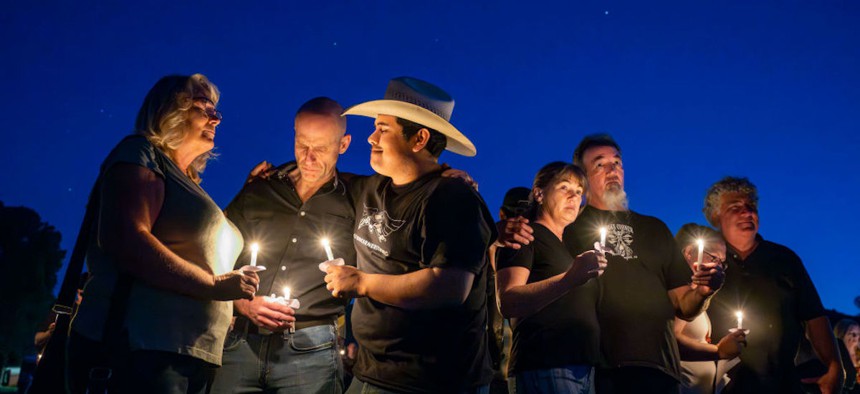Researchers quantify communities' risk of a mass shooting

Community members join a candlelight vigil in honor of the victims of an Aug. 23 shooting at Cook's Corner bar in Trabuco Canyon, California, on Sept. 6 2023. Three victims were killed, and six were injured. Photo by Leonard Ortiz/MediaNews Group/Orange County Register via Getty Images
The new statistical analysis model would allow state and local agencies to understand the risk of a mass shooting and what they can do to prepare ahead of time.
This year, the U.S. has already seen nearly 500 mass shootings, according to the nonprofit Gun Violence Archive, which defines a mass shooting as an incident in which four or more people are injured or killed. Shootings take a toll on a community. An attack at a school or hospital not only disrupts the lives of victims, bystanders, responders and their families, but it also damages the trust residents have in their public institutions to keep them safe.
Despite the growing number of incidents, gun violence is difficult to anticipate, because shootings seem to occur randomly. That uncertainty is especially acute for smaller communities that may not have the budget or resources for prevention and mitigation.
But researchers at Iowa State University have developed a statistical analysis model to calculate the probability of a mass shooting at specific locations, such as schools or retail stores. For instance, the analysis projected that K-12 schools in California could experience 5.8 mass shootings in a year.
The model considers population data, unemployment rates and data on the number of recorded mass shootings collected by the Gun Violence Archive and the Violence Project, a nonprofit research organization dedicated to ending gun violence.
The analysis gives local officials a framework for understanding the probability of a mass shooting in their communities so they can determine adequate funding and policies to prevent and mitigate the risk of a fatal event, said Xue Lei, a research assistant at Iowa State University and co-author of a recent report on the model. Officials, for instance, could determine that the risk of a school shooting warrants implementing risk mitigation strategies. That could include training programs for teachers on how to respond to active shooter threats or investing in metal detectors and security personnel at school entrances.
Officials can adopt the researchers’ methodology to conduct their own analyses with local data for a more accurate risk analysis, Lei said. The analysis can also be conducted at the national and state levels, allowing the federal government and states to target funding as necessary.
The model can be applied to incidents beyond gun violence that require advanced preparation like natural disasters, Lei said. An emergency management department, for instance, could use the statistical model to determine the risk of a hurricane using population data and data on storm frequency. If an analysis indicated the probability of a hurricane in the next year is higher than that of a mass shooting, then officials could refocus resources.
“In a constrained resource environment where state and local governments, school administrators [and] law enforcement agencies … need to consider carefully what issues deserve additional resources and money, understanding the probability of different risks can help guide and prioritize those investments,” the report said.






